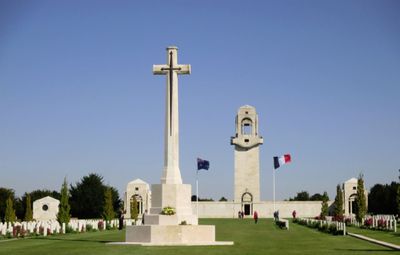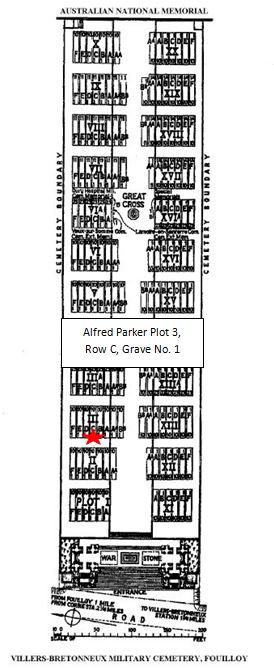Difference between revisions of "Alfred Parker"
From Our Contribution
(→War Service) |
|||
| Line 56: | Line 56: | ||
Alfred entered camp on 2 Mar 1916 and on 1 Apr 1916 he was sent to the NCO's school at Belmont. On 20 Jun 1916 he was promoted Corporal with the 3rd reinforcement draft for the 44th Battalion, and on 12 Jul 1916 to Sergeant for the journey to England. | Alfred entered camp on 2 Mar 1916 and on 1 Apr 1916 he was sent to the NCO's school at Belmont. On 20 Jun 1916 he was promoted Corporal with the 3rd reinforcement draft for the 44th Battalion, and on 12 Jul 1916 to Sergeant for the journey to England. | ||
| − | On 2 Dec 1916 on arrival in England he was allotted to | + | On 2 Dec 1916 on arrival in England he was allotted to the [[11th Training Battalion]] where he reverted to Private, but on 1 Jan 1917 he was promoted again to Corporal, and to temporary Sergeant while with the [[11th Training Battalion]]'s Cadre. From 12 - 14 Feb 1917 Alfred attended a course at the Southern Command Bombing School at Lyndhurst and qualified as an instructor in bomb throwing. On 11 Mar 1917 he reported sick to the [[Fargo Military Hospital]], returning to his unit on 30 Mar 1917. |
Proceeding overseas to France, Alfred again reverted to Private when he embarked in Folkestone on 2 Oct 1917. He reached the [[44th Battalion]] and was taken on strength by them on 7 Oct 1917. On 4 Nov 1917 Alfred was again promoted to Temporary Sergeant. This rank was to be confirmed on 4 Jan 1918. | Proceeding overseas to France, Alfred again reverted to Private when he embarked in Folkestone on 2 Oct 1917. He reached the [[44th Battalion]] and was taken on strength by them on 7 Oct 1917. On 4 Nov 1917 Alfred was again promoted to Temporary Sergeant. This rank was to be confirmed on 4 Jan 1918. | ||
Latest revision as of 00:32, 17 August 2021
 | |
| Personal Information | |
|---|---|
| Date of Birth | c1882 |
| Place of Birth | Eastwood, Nottinghamshire, England |
| Death | 4 Jul 1918, aged 36 |
| Place of Death | Hamel, France |
| Age at Enlistment | 34 years |
| Description |
5'10" (1.78m) tall ; 180lbs 81.647 kg ; fair complexion ; hazel eyes ; dark brown hair |
| Occupation | Station Master |
| Religion | Church of England |
| Address | Gosnells, Western Australia |
| Next of Kin | Wife , Mrs Sarah Hannah Parker |
| Military Information | |
| Reg Number | 2032 |
| Date of Enlistment | 3 Feb 1916 |
| Rank | Sergeant |
| Unit/Formation | 44th Battalion, 3rd Reinforcement posted to D Company |
| Date of Embarkation | 10 Oct 1916 ‒ 2 Dec 1916 |
| Ship Embarked On | HMAT A23 Suffolk |
| Fate | Killed in Action 4 Jul 1918 at Hamel |
| Monument |
Gosnells War Memorial Gosnells Road Board Honour Roll Gosnells Ward Honour Roll |
| Medals |
British War Medal Victory Medal |
Contents
Pre War
Arrived in Australia as a 26 year old, having served for 2 years with the Royal Marines Artillery on the Orient Line's SS Ophir which left London on 10 May 1912. His wife Hannah who he married in 1902, and son Stephen joined him the following year aboard the White Star Line's SS Belgic which departed Liverpool on 21 May 1913.
War Service
Alfred entered camp on 2 Mar 1916 and on 1 Apr 1916 he was sent to the NCO's school at Belmont. On 20 Jun 1916 he was promoted Corporal with the 3rd reinforcement draft for the 44th Battalion, and on 12 Jul 1916 to Sergeant for the journey to England.
On 2 Dec 1916 on arrival in England he was allotted to the 11th Training Battalion where he reverted to Private, but on 1 Jan 1917 he was promoted again to Corporal, and to temporary Sergeant while with the 11th Training Battalion's Cadre. From 12 - 14 Feb 1917 Alfred attended a course at the Southern Command Bombing School at Lyndhurst and qualified as an instructor in bomb throwing. On 11 Mar 1917 he reported sick to the Fargo Military Hospital, returning to his unit on 30 Mar 1917.
Proceeding overseas to France, Alfred again reverted to Private when he embarked in Folkestone on 2 Oct 1917. He reached the 44th Battalion and was taken on strength by them on 7 Oct 1917. On 4 Nov 1917 Alfred was again promoted to Temporary Sergeant. This rank was to be confirmed on 4 Jan 1918.
On 9 Jan 1918 he reported to the 9th Field Ambulance with scabies, and the same day they sent him on to the 1st Australian Casualty Clearing Station. He was discharged to duty on 12 Jan 1918.
Alfred was Killed in Action on 4 Jul 1918 at the Battle for Hamel. During the battle 'B' Company of 'I' Battalion of the 131st US Infantry regiment was attached to the Battalion. Two days prior to the battle William Hughes, Prime Minister of Australia addressed the men before they marched along the canal banks to a position near Hamelet where they settled for the night. The following day was one of rest with no movement permitted lest they be observed by the enemy. It was at this point that the American troops were withdrawn from the field.
At 1:00am on 4 Jul 1918 the battalion moved forward to be at their start point by 2:45am, and did so without any casualties, ready for the attack timed for 3:10am. Four minutes after the artillery barrage began the troops rose to their feet and followed it as it advanced. The 43rd Battalion was in front of the 44th Battalion, and easily achieved their objective after which the 44th leap frogged their position to advance on the final objective at the top of the rise above the village. The battalion separated into two forces, one passed around Hamel to the left, and the other to the right. Enemy machine gun fire caused some casualties as they approached the final objective, the enemy trenches atop the Wolfsberg, a steep hill behind the town.
The German artillery in the late afternoon carried out a fierce barrage on their lost trenches, now sheltering the 44th Battalion, and at 10:30pm the Germans counter attacked and after fierce hand to hand fighting captured some of 'A' Company's trenches. After a fierce bombing and bayonet fight they were eventually ejected, losing over 100 dead and 56 prisoners. This is the most likely time during the battle that Alfred was killed.
In September 1919, Sarah and Stephen boarded SS Orontes in Fremantle and returned to England. Sarah later remarried, to Kirwan H Gyllenship Milton in May 1920. Her address at the time was 57 Leighville Grove, Leigh on Sea, Essex.
Notes

